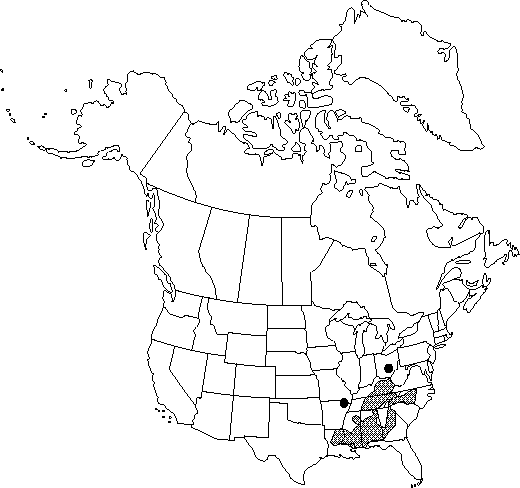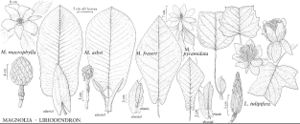Difference between revisions of "Magnolia macrophylla"
Fl. Bor.-Amer. 1: 327. 1803.
FNA>Volume Importer |
imported>Volume Importer |
||
| (7 intermediate revisions by 2 users not shown) | |||
| Line 13: | Line 13: | ||
}}{{Treatment/ID/Special_status | }}{{Treatment/ID/Special_status | ||
|code=F | |code=F | ||
| − | |label= | + | |label=Illustrated |
}} | }} | ||
|basionyms= | |basionyms= | ||
|synonyms={{Treatment/ID/Synonym | |synonyms={{Treatment/ID/Synonym | ||
| − | |name= | + | |name=Magnolia michauxiana |
|authority=de Candolle | |authority=de Candolle | ||
| + | |rank=species | ||
}} | }} | ||
|hierarchy=Magnoliaceae;Magnolia;Magnolia macrophylla | |hierarchy=Magnoliaceae;Magnolia;Magnolia macrophylla | ||
| Line 27: | Line 28: | ||
}}<!-- | }}<!-- | ||
| − | --><span class="statement" id="st- | + | --><span class="statement" id="st-undefined" data-properties=""><b>Trees,</b> deciduous, single-trunked, to 15(-32) m. <b>Bark</b> yellowish to gray, smooth. <b>Pith</b> homogeneous. <b>Twigs</b> and foliar buds silky-pubescent. <b>Leaves</b> crowded in terminal whorl-like clusters; stipules (9-)11-17 × 3-6.5 cm, abaxially pilose, glandular. <b>Leaf</b> blade broadly elliptic to obovate-oblong, 50-110 × 15-30 cm, base truncate to deeply cordate or auriculate, apex acute to short-acuminate or obtuse; surfaces abaxially chalky white, sometimes pale green to glaucous, pilose, adaxially deep green, glabrous. <b>Flowers</b> solitary, fragrant, 35-40(-50) cm across; spathaceous bracts 2, outer bract abaxially rusty gray, inner bract thinner, glabrous; tepals creamy white, glandular, innermost whorl purple-blotched at base, outermost segments strongly reflexed, greenish; stamens (300-)350-580, 12.5-24.5 mm; filaments white; pistils 50-80. <b>Follicetums</b> globose-ovoid, 5-8 × 5-7 cm; follicles short-beaked, distally appressed silky-pubescent. <b>Seeds</b> ± ovoid, 10-12 mm, pointed, aril orange-red. <b>2n</b>=38.</span><!-- |
-->{{Treatment/Body | -->{{Treatment/Body | ||
| Line 34: | Line 35: | ||
|elevation=150-300 m | |elevation=150-300 m | ||
|distribution=Ala.;Ark.;Ga.;Ky.;La.;Miss.;N.C.;Ohio;Tenn.;Va. | |distribution=Ala.;Ark.;Ga.;Ky.;La.;Miss.;N.C.;Ohio;Tenn.;Va. | ||
| − | |discussion=<p>The disposition of Magnolia macrophylla and its close relative M. ashei has been perplexing since M. ashei was described. Some investigators have treated them as geographic varieties or subspecies, and this has some questionable merit. In the foliar state M. macrophylla is hardly, if at all, distinguishable from M. ashei, but in other morphologic details of flower and fruit, they are readily distinguished. They also differ in the floral odors, which are distinct and chemically different (L.B. Thien et al. 197). Magnolia macrophylla and M. ashei are allopatric. Magnolia macrophylla is a much larger, usually single-trunked tree of the piedmont with a wider distribution, larger leaves, more stamens, larger stipules, and both filiform and flagelliform trichomes on the leaves. The follicetum is nearly globose-ovoid, with more pistils and larger seeds. Magnolia macrophylla produces the largest leaves and flowers of any species of the genus.</p><!-- | + | |discussion=<p>The disposition of <i>Magnolia macrophylla</i> and its close relative <i>M. ashei</i> has been perplexing since <i>M. ashei</i> was described. Some investigators have treated them as geographic varieties or subspecies, and this has some questionable merit. In the foliar state <i>M. macrophylla</i> is hardly, if at all, distinguishable from <i>M. ashei</i>, but in other morphologic details of flower and fruit, they are readily distinguished. They also differ in the floral odors, which are distinct and chemically different (L.B. Thien et al. 197). <i>Magnolia macrophylla</i> and <i>M. ashei</i> are allopatric. <i>Magnolia macrophylla</i> is a much larger, usually single-trunked tree of the piedmont with a wider distribution, larger leaves, more stamens, larger stipules, and both filiform and flagelliform trichomes on the leaves. The follicetum is nearly globose-ovoid, with more pistils and larger seeds. <i>Magnolia macrophylla</i> produces the largest leaves and flowers of any species of the genus.</p><!-- |
| − | --><p>In Arkansas Magnolia macrophylla was known from a single disjunct locality in Clay County, where only two trees were recorded in 1981 (R.B. Figlar 1981). A survey in 1995 failed to locate the species in the same site.</p><!-- | + | --><p>In Arkansas <i>Magnolia macrophylla</i> was known from a single disjunct locality in Clay County, where only two trees were recorded in 1981 (R.B. Figlar 1981). A survey in 1995 failed to locate the species in the same site.</p><!-- |
--><p>This handsome tree is occasionally cultivated. A close relative, M. dealbata Zuccarini, occurs in Mexico.</p><!-- | --><p>This handsome tree is occasionally cultivated. A close relative, M. dealbata Zuccarini, occurs in Mexico.</p><!-- | ||
| − | --><p>The largest known tree of Magnolia macrophylla, 32m in height with a trunk diameter of 53 cm, is recorded from Daniel Boone National Forest, Tight Hollow, Kentucky (American Forestry Association 1994).</p><!-- | + | --><p>The largest known tree of <i>Magnolia macrophylla</i>, 32m in height with a trunk diameter of 53 cm, is recorded from Daniel Boone National Forest, Tight Hollow, Kentucky (American Forestry Association 1994).</p><!-- |
| − | --><p>The Cherokee tribe used Magnolia macrophylla, mainly the bark, as an analgesic, antidiarrheal, gastrointestinal aid, respiratory aid, and toothache remedy (D.E. Moerman 1986).</p> | + | --><p>The Cherokee tribe used <i>Magnolia macrophylla</i>, mainly the bark, as an analgesic, antidiarrheal, gastrointestinal aid, respiratory aid, and toothache remedy (D.E. Moerman 1986).</p> |
|tables= | |tables= | ||
|references= | |references= | ||
| Line 47: | Line 48: | ||
-->{{#Taxon: | -->{{#Taxon: | ||
name=Magnolia macrophylla | name=Magnolia macrophylla | ||
| − | |||
|authority=Michaux | |authority=Michaux | ||
|rank=species | |rank=species | ||
|parent rank=genus | |parent rank=genus | ||
| − | |synonyms= | + | |synonyms=Magnolia michauxiana |
|basionyms= | |basionyms= | ||
|family=Magnoliaceae | |family=Magnoliaceae | ||
| Line 61: | Line 61: | ||
|publication title=Fl. Bor.-Amer. | |publication title=Fl. Bor.-Amer. | ||
|publication year=1803 | |publication year=1803 | ||
| − | |special status=Endemic; | + | |special status=Endemic;Illustrated |
| − | |source xml=https:// | + | |source xml=https://bitbucket.org/aafc-mbb/fna-data-curation/src/2e0870ddd59836b60bcf96646a41e87ea5a5943a/coarse_grained_fna_xml/V3/V3_186.xml |
|genus=Magnolia | |genus=Magnolia | ||
|species=Magnolia macrophylla | |species=Magnolia macrophylla | ||
| − | |||
| − | |||
| − | |||
| − | |||
| − | |||
| − | |||
| − | |||
| − | |||
| − | |||
| − | |||
| − | |||
| − | |||
| − | |||
| − | |||
| − | |||
| − | |||
| − | |||
| − | |||
| − | |||
| − | |||
| − | |||
| − | |||
| − | |||
| − | |||
| − | |||
| − | |||
| − | |||
| − | |||
| − | |||
| − | |||
| − | |||
| − | |||
| − | |||
| − | |||
| − | |||
| − | |||
| − | |||
| − | |||
| − | |||
| − | |||
| − | |||
| − | |||
| − | |||
| − | |||
| − | |||
| − | |||
| − | |||
| − | |||
| − | |||
| − | |||
| − | |||
| − | |||
| − | |||
}}<!-- | }}<!-- | ||
-->[[Category:Treatment]][[Category:Magnolia]] | -->[[Category:Treatment]][[Category:Magnolia]] | ||
Latest revision as of 21:46, 5 November 2020
Trees, deciduous, single-trunked, to 15(-32) m. Bark yellowish to gray, smooth. Pith homogeneous. Twigs and foliar buds silky-pubescent. Leaves crowded in terminal whorl-like clusters; stipules (9-)11-17 × 3-6.5 cm, abaxially pilose, glandular. Leaf blade broadly elliptic to obovate-oblong, 50-110 × 15-30 cm, base truncate to deeply cordate or auriculate, apex acute to short-acuminate or obtuse; surfaces abaxially chalky white, sometimes pale green to glaucous, pilose, adaxially deep green, glabrous. Flowers solitary, fragrant, 35-40(-50) cm across; spathaceous bracts 2, outer bract abaxially rusty gray, inner bract thinner, glabrous; tepals creamy white, glandular, innermost whorl purple-blotched at base, outermost segments strongly reflexed, greenish; stamens (300-)350-580, 12.5-24.5 mm; filaments white; pistils 50-80. Follicetums globose-ovoid, 5-8 × 5-7 cm; follicles short-beaked, distally appressed silky-pubescent. Seeds ± ovoid, 10-12 mm, pointed, aril orange-red. 2n=38.
Phenology: Flowering spring.
Habitat: Alluvial woods and sheltered valleys, piedmont
Elevation: 150-300 m
Distribution

Ala., Ark., Ga., Ky., La., Miss., N.C., Ohio, Tenn., Va.
Discussion
The disposition of Magnolia macrophylla and its close relative M. ashei has been perplexing since M. ashei was described. Some investigators have treated them as geographic varieties or subspecies, and this has some questionable merit. In the foliar state M. macrophylla is hardly, if at all, distinguishable from M. ashei, but in other morphologic details of flower and fruit, they are readily distinguished. They also differ in the floral odors, which are distinct and chemically different (L.B. Thien et al. 197). Magnolia macrophylla and M. ashei are allopatric. Magnolia macrophylla is a much larger, usually single-trunked tree of the piedmont with a wider distribution, larger leaves, more stamens, larger stipules, and both filiform and flagelliform trichomes on the leaves. The follicetum is nearly globose-ovoid, with more pistils and larger seeds. Magnolia macrophylla produces the largest leaves and flowers of any species of the genus.
In Arkansas Magnolia macrophylla was known from a single disjunct locality in Clay County, where only two trees were recorded in 1981 (R.B. Figlar 1981). A survey in 1995 failed to locate the species in the same site.
This handsome tree is occasionally cultivated. A close relative, M. dealbata Zuccarini, occurs in Mexico.
The largest known tree of Magnolia macrophylla, 32m in height with a trunk diameter of 53 cm, is recorded from Daniel Boone National Forest, Tight Hollow, Kentucky (American Forestry Association 1994).
The Cherokee tribe used Magnolia macrophylla, mainly the bark, as an analgesic, antidiarrheal, gastrointestinal aid, respiratory aid, and toothache remedy (D.E. Moerman 1986).
Selected References
None.
